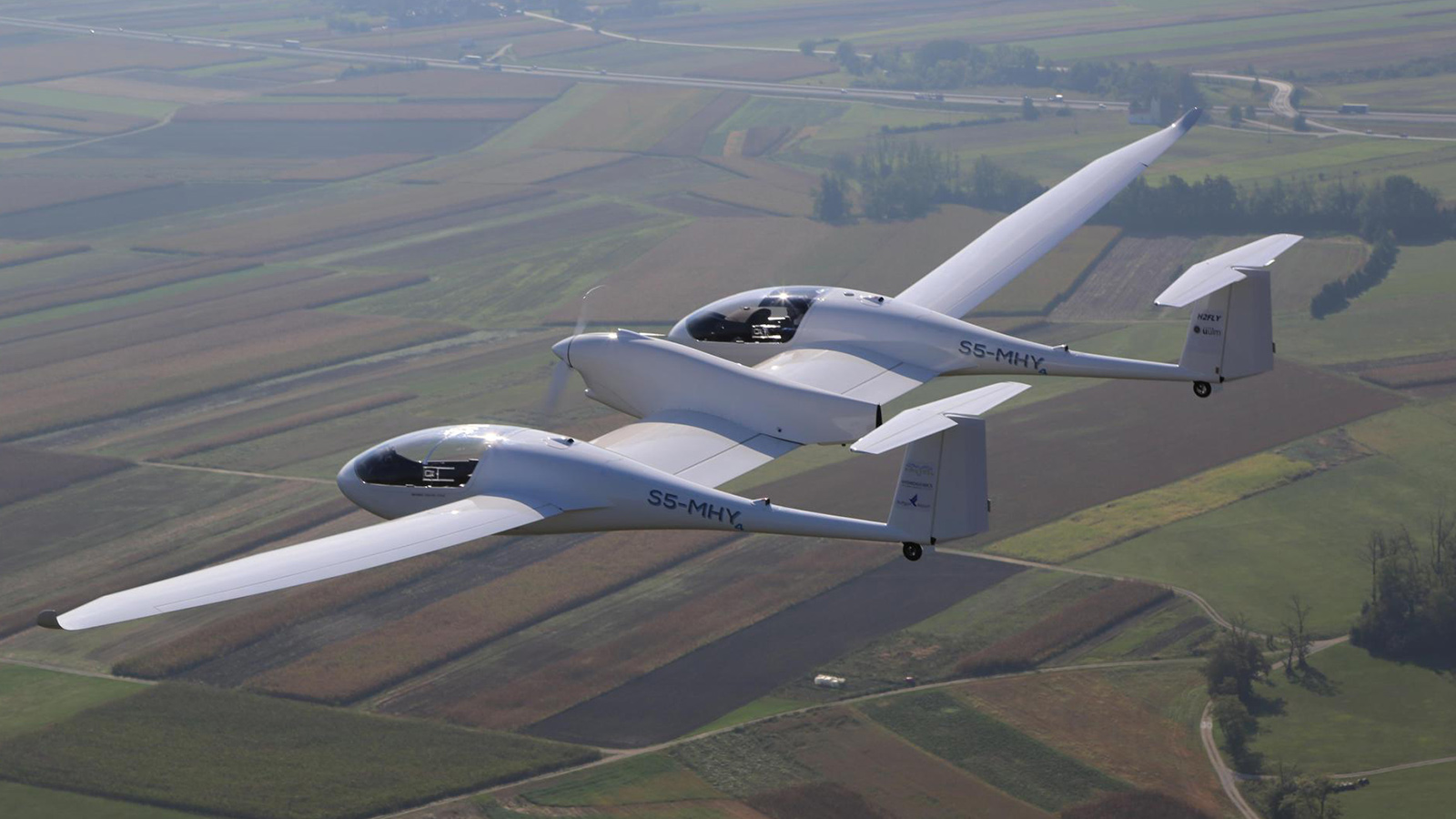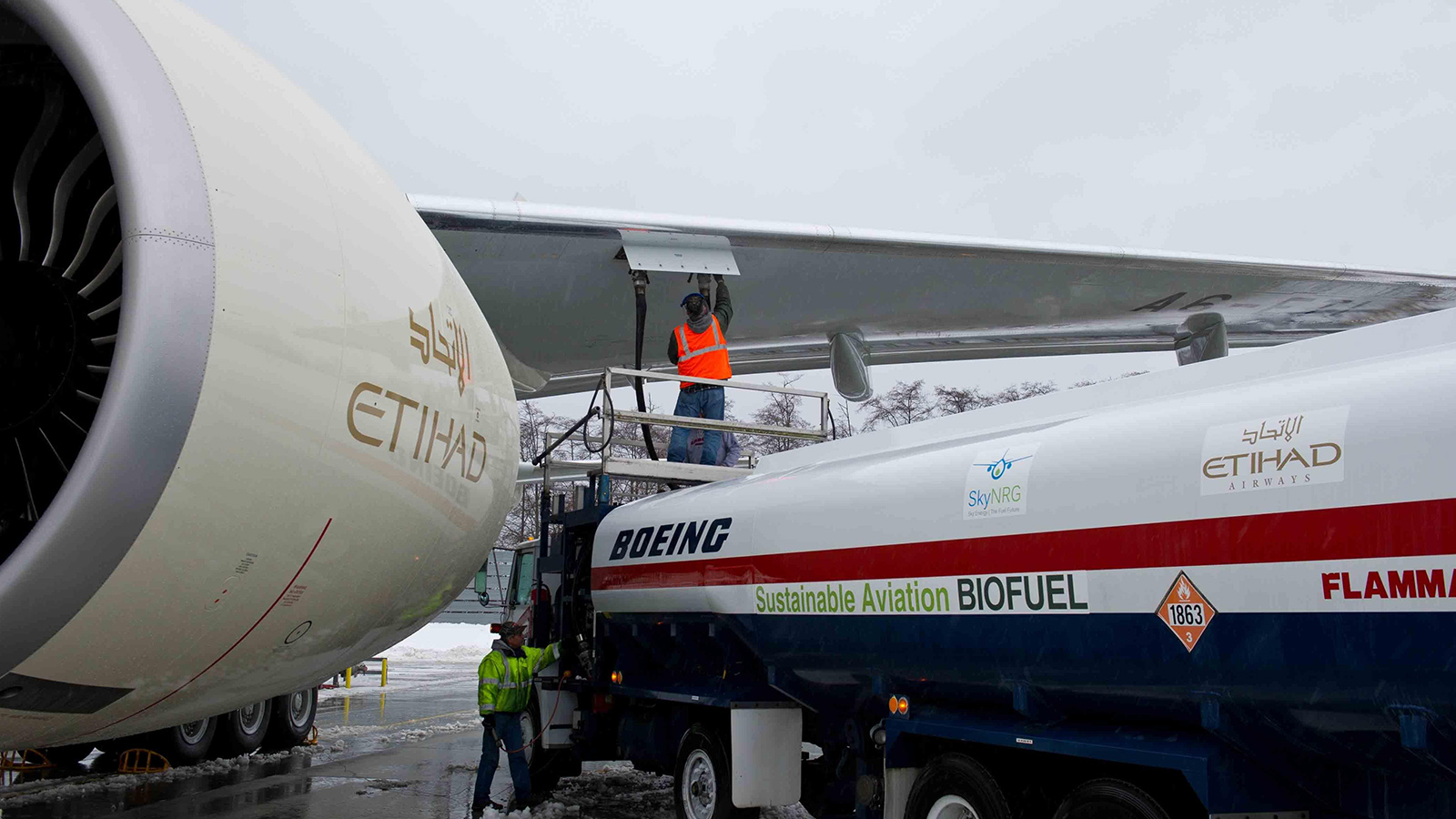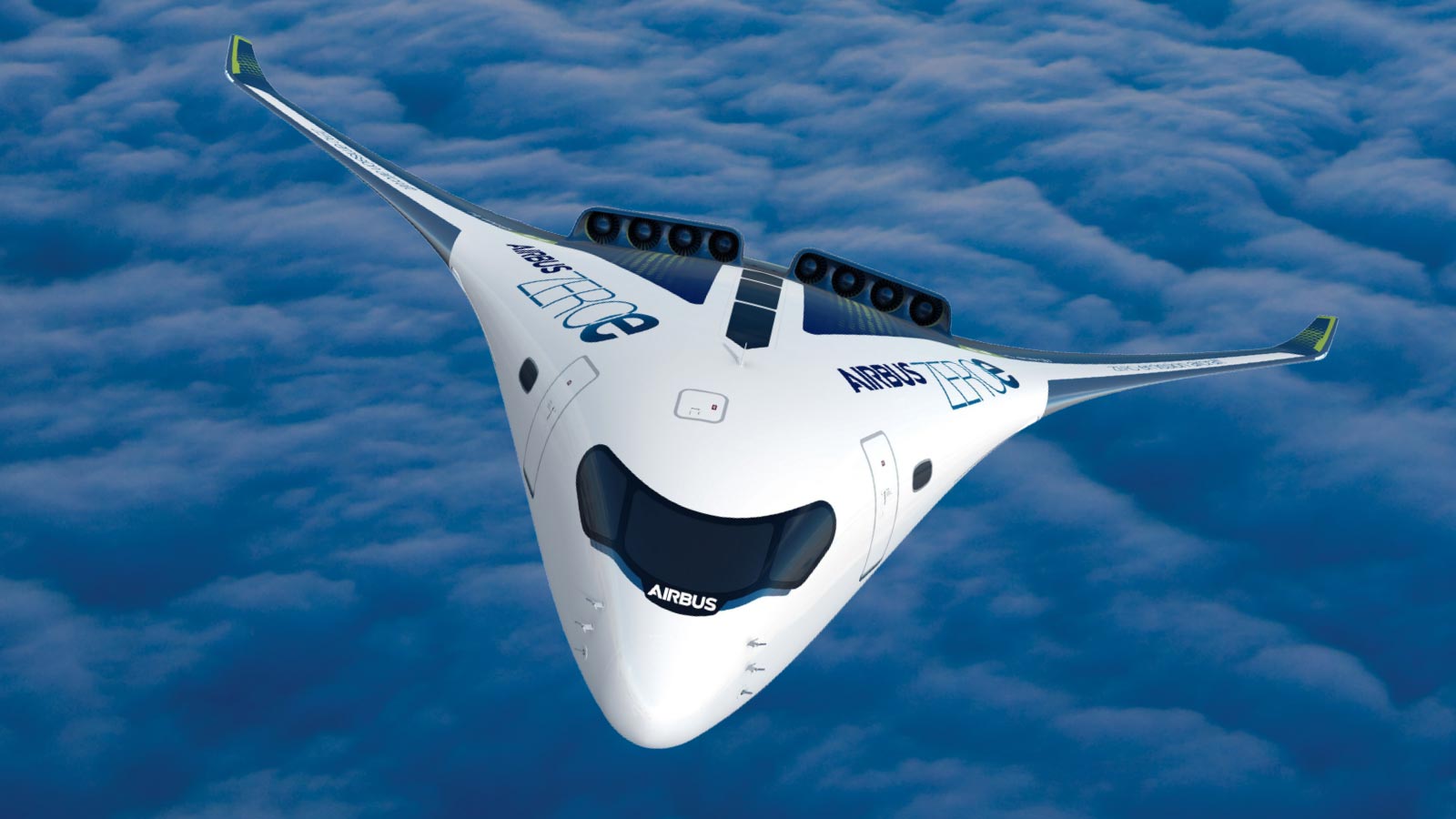Stay Up to Date
Submit your email address to receive the latest industry and Aerospace America news.
The world’s top two commercial aircraft manufacturers have radically different views about how to curb the carbon footprint of air travel between now and 2050. Airbus’ vision of developing hydrogen-powered aircraft for all but the longest routes has produced an air of excitement, while Boeing’s caution about hydrogen could provide a reality check. Keith Button spoke to executives from both companies. Here is what he learned.
Airbus’ quest to build a 100- to 200-passenger airliner fueled by hydrogen has, with only a dash of hyperbole, all the elements of a superhero movie:
- The fate of the planet cast as hanging in the balance? Check.
- Potentially insurmountable technical obstacles? Naturally.
- A seemingly impossible deadline? But of course.
- A showdown of ideas between gargantuan archrivals? Yep.
Airbus plans to spend upward of a billion euros ($1.2 billion) through 2024 studying various concepts and building a demonstrator that could lead to a hydrogen-powered passenger plane capable of carrying 100 to 200 people. Then, if all goes well, the company would freeze the design and spend billions more on construction, certification and manufacturing of the production version so airlines can start flying them by 2035. In the most optimistic scenario, the initial versions of these aircraft would have a maximum range of 3,700 kilometers, good enough to get from Chicago to Los Angeles or Beijing to Tokyo, but not to cross the Atlantic Ocean. So Airbus will in parallel support the continued rollout of sustainable aviation fuels made from plants, wastes and other climate-friendly sources as a drop-in replacement for the kerosene jet fuel burned by today’s aircraft.
Meanwhile, rival Boeing has closely examined the tradeoffs of hydrogen and has dismissed it as a serious alternative anytime soon, preferring to hitch its carbon-neutral cred to SAFs. The stakes are high, with the aviation industry under pressure to reduce its contribution to global warming, estimated at about 3.5% of the human-induced total, and reach carbon neutrality by 2050. Airbus’ success or failure could determine whether hydrogen ultimately dominates or goes down as a footnote in aviation history, like the Soviet Union’s short-lived attempt at a hydrogen airliner 30 years ago.
Emission impossible?
Each of the four conceptual drawings that Airbus unveiled in virtual events last year would have unique advantages. Airbus plans to “evaluate and validate” the viability of these concepts. As Amanda Simpson, vice president of research and technology for Airbus Americas, puts it, they will “spur debate about the technology that’s necessary to move things forward.” The 2025 design “may look very similar to one of the four concepts, it could be something slightly different, or it could become something completely different,” adds Simpson, who is the U.S. lead for the company’s ZEROe initiative.
- The most recent concept, released in December, shows a plane equipped with six hydrogen pods, three to a wing, each pod with its own liquid hydrogen tank, cooling system, fuel cell to generate electricity and motor to turn the rotors. The pods could be quickly swapped out for refueling or maintenance. Holding hydrogen in the pods would mean the fuel wouldn’t take up space in the fuselage. Designers could create variations with four or six pods for different passenger loads and flight distances. This is the only concept that proposes electric power without combustion.
- Other concepts include a twin-engine turboprop plane and a twin-turbofan. Both would share an advantage over kerosene-fueled airliners by carrying their fuel, hydrogen in this case, in the fuselage instead of the wings. Designers would have freedom to plan longer, narrower wings with better lift-to-drag ratios. Of course, a disadvantage would be less room for passengers, since hydrogen must be stored in spherical or cylindrical tanks to keep the fuel cold, and this would take up one-third of the space in the fuselage. These concepts also call for thrust to be delivered by turbine engines that would be smaller and more fuel efficient than today’s kerosene-powered turbine engines, whether those are jet engines or turboprops. The engines would be sized for cruise flight instead of for maximum thrust situations, reducing the amount of hydrogen burned and saving weight. As hybrids, the planes would supplement hydrogen combustion with hydrogen fuel cells that would generate electricity to boost power for climbing. Typical kerosene-fueled engines are oversized for maximum thrust, so “when you pull the throttle back for cruise, you still have to turn all the parts that would be necessary for climb, even though you’re doing it at a reduced thrust setting,” Simpson says. Each fuel cell would contain hydrogen gas boiled off from the liquid hydrogen and would supply power to move components electrically instead of with hydraulic pumps, for instance.
- The most futuristic looking of the four concepts, a blended-wing body, might be the best design for maximizing the volume required for carrying passengers along with the spherical or cylindrical tanks required to keep liquid hydrogen cool.
For any of these concepts to be validated, working with the right propulsion developer or developers will be crucial. Airbus says it’s negotiating with engine manufacturers to provide the propulsion for the demonstration aircraft that would be inspired by one or more of these concepts.
The ultimate size and range of the 2025 design will depend on what best fits the market, Simpson says. “Who’s going to make that decision? That’s a combination of our engineering teams working with our marketing folks who are in communication with potential customers. You never launch an aircraft without having a customer base.” While Airbus’ hydrogen plane design team is in Europe, Airbus Americas is identifying emerging technologies or suppliers that could assist, talking to North America-based airlines about what they might want, and evaluating whether hydrogen supply and distribution will exist by 2035 to support hydrogen-powered aircraft.
Historically, Airbus has taken about seven years to shepherd a conceptual passenger aircraft through the design phase, flight testing, production and into service. But that was for a hydrocarbon-fueled, tube-and-wing design with relatively modest innovations. This time, Airbus is projecting a longer period because “we’re talking about lots of new technologies here, not just the propulsion, but some other revolutionary concepts, technology going into the design and the manufacturing of this aircraft,” Simpson says.
As daunting as the challenges are, hydrogen-powered concepts aren’t unheard of. Simpson points to U.S. Air Force flights of hydrogen planes in the 1950s and the Soviet Union’s hydrogen-powered airliner of the late 1980s. The Soviets flew a hydrogen-combustion test plane, the Tupolev Tu-155, over the course of several years starting in 1988.
Boeing remains unconvinced
Where Airbus is bullish on hydrogen, a Boeing executive provided a forceful account for why the company remains cautious. Hydrogen-powered aircraft would present “substantial unsolved engineering and science problems,” says Brian Yutko, Boeing’s chief engineer for sustainability and future mobility. “That doesn’t mean it’s impossible, but it just means that there’s risk associated with it.”
The technology readiness levels for innovations that a hydrogen-powered airliner would require are so low that it will take years just to estimate any potential future role for them, he cautions. That said, the company is working to “understand the art of the possible” for hydrogen from an engineering standpoint and whether the specific safety and certification risks could be overcome, Yutko says. Boeing won’t say what it’s spending on hydrogen research or whether it’s anything near Airbus’ commitment.
Chief among the safety concerns with hydrogen is how to inert the fuel tanks to reduce flammability. Today’s airliners do that by venting vapors from fuel tanks, and by filling the air space in the tanks with an inert gas like nitrogen.
Engineers must figure out how to safely vent the hydrogen gas that would boil off the liquid hydrogen, Yutko says.
On the inerting issue, Simpson says, the difference is that as liquid hydrogen is consumed, the tank won’t need to be backfilled with a gas as a kerosene tank would for safety. The void would be filled with hydrogen gas as it boils off. Excess hydrogen gas would be removed via pressure valves to fuel hydrogen fuel cells or to the atmosphere, where it mixes with the atmosphere and rises.
Hydrogen aviation advocates say the safety risks of hydrogen are often overblown due in part to the mental image of the infamous Hindenburg airship fire in 1937.
“Safety is going to be the No. 1 design criteria,” Simpson says. “There is no detailed design yet, but I can guarantee that the technology has improved quite a bit since the 1930s.”
A sizeable amount of hydrogen is already produced, shipped and consumed without becoming a safety issue, Simpson says. Indeed, the U.S. alone produces 10 million metric tons of hydrogen per year to power, among other things, 35,000 forklifts and 8,800 fuel-cell cars, according to the U.S. Department of Energy. “I think hydrogen will be safer than kerosene has been,” Simpson adds.
If one looks at the rollout of new aviation technologies through history, hydrogen-fueled airplanes would actually pose less of a safety risk than fly-by-wire planes did when they were introduced, says Josef Kallo, an energy systems integration coordinator at DLR, the German Aerospace Center, and designer of the hydrogen fuel cell-powered Hy4 four-seat aircraft. Hydrogen’s necessary safety precautions are well-known, while fly-by-wire and its software presented lots of unknown possibilities, Kallo says. “You know how hydrogen behaves; you know liquid hydrogen’s possibilities to explode, to burn, and you stay away from it.”
Hydrogen vs. sustainable fuels
While hydrogen-powered aircraft would not emit carbon dioxide, that does not necessarily mean they would not have a carbon footprint. Yutko notes that, if something isn’t done, hydrogen planes would actually increase carbon in the atmosphere. Assuming that liquid hydrogen would be produced by electricity, 60% of that electricity today would be produced from fossil fuels. All told, producing and distributing liquid hydrogen currently requires five times more energy than does production and distribution of kerosene jet fuel.
“Even if you magically have the hydrogen airplanes today, using them would take us back decades in terms of net carbon to the atmosphere,” Yutko argues.
For that and other reasons, Boeing believes SAFs will offer the most immediate reduction in carbon emissions for aviation over the next 20 to 30 years, and it plans to build all its aircraft capable of flying with 100% SAF by 2030, Yutko says. Airbus is also committed to making its planes capable of flying with 100% SAF but hasn’t announced when it will happen. The company flew an A-350 test plane on 100% SAF earlier this year. Adopting SAFs also presents challenges, starting with how to scale up use of these fuels, which is currently minuscule. But airlines have pledged to burn more SAFs, which in Boeing’s view validates its argument that SAFs will be the primary path to reducing carbon emissions before 2050. The commercial aircraft fleet of 2050 will look a lot like today’s fleet, as will their turbine engines, because planes have 20- to 30-year lifespans, so the best way to reduce emissions over that period will be through SAFs, Yutko says.
With 30,000 airliners flying today, SAFs will have to be part of the near-term solution for reducing aviation’s climate impact, but SAFs still put carbon, sulfur and other contaminants in the air that hydrogen does not, Simpson says.
A hydrogen airliner would be just “the first entry into a subset of the marketplace,” Simpson says. “As more experience is gained operating a hydrogen-powered aircraft, we expect that there will be more models that will have higher payload and longer range.” Over time, they will supplement and then replace the planes that now burn kerosene.
Super cool
Liquid hydrogen is very cold — minus 253 degrees Celsius. Therefore, the fuel-cell components that would generate electricity for propulsion would be heavy and require a lot of insulation, especially at high altitudes, unless a solution is found. So Airbus is exploring how it might super-cool the electrical system to make it superconducting, which would reduce the size and weight of the electrical components and the amount of heat generated.
Because superconductivity reduces electrical resistance, designers could reduce a 3,000-volt system for electric propulsion to 500 volts, halving the weight of the current limiters, motor control units, cables, electric motors and other electrical components while reducing the heat they generate. A high-voltage system would require more electrical insulation to prevent arcing at high altitudes, so with lower voltages and less insulation the electrical components could be smaller. With less heat from electrical components, designers could plan for smaller cooling systems, which also saves weight. Superconducting would also reduce electrical losses by more than half, so the airplane would need less electric power and its hydrogen fuel would last longer, extending its flight range.
Airbus has until 2025 to make a go/no-go decision on moving ahead. The decision will depend not only on whether it has a feasible design, but whether sufficient hydrogen fuel production and distribution will be in place by 2035.
“We are committed to a zero-emission aircraft by 2035 and right now we don’t see anything on our side, on the aviation side, that precludes that. But we’re still a couple of years away” from the 2025 decision “and we still have some questions that need to be answered,” Simpson says.
For the design piece of the 2025 decision, she says, “the concepts are out there. It’s just refining them so that they would be appropriate for an airliner that is going to be used for years and multiple flights per day.”
But even with a perfect design, other problems could nix Airbus’ plans. One measure of the degree of difficulty faced by Airbus is the number of issues in the running for the unofficial title of “biggest challenge.” For Simpson, the biggest will be building up “the hydrogen ecosystem”: everything from producing it to delivering it to getting it into the airplanes.
Getting that ecosystem in place will also be an issue for the auto, trucking, rail and marine industries as they adopt zero-emission hydrogen-fueled concepts.
“That’s not going to happen by 2025, but the aircraft aren’t going to be there until the mid-30s,” Simpson says. So to make a decision in 2025 on whether to move ahead, Airbus will be evaluating whether there is “momentum toward that goal” of developing hydrogen production and removing barriers to production, such as its cost.
For Kallo, the biggest challenge is the absence of safety certification standards from FAA or the European Union Aviation Safety Agency for hydrogen-powered planes. “Nobody knows at the moment what is the qualification base,” he says, which is stunting the design and development of hydrogen concept technologies.
Ron Van Manen, head of strategic development for Clean Sky, a European private-public partnership to fund environmentally friendly plane research, says one of the biggest challenges for a hydrogen combustion design is the fuel system: “The really tricky bit is getting the fuel into the combustion chamber.” A liquid at minus 253 degrees Celsius must be piped to a hot engine and transformed to gas while precisely controlling the temperatures and pressures along the way.” The other is storing liquid hydrogen on the aircraft without weighing down the airplane too much, because the fuel tanks are typically double-walled and insulated.
Placing bets
Hydrogen has two big advantages over SAFs, Van Manen says: It costs three times as much energy to create SAFs than it does to create liquid hydrogen. And unlike SAFs, hydrogen is completely carbon-free, not just net carbon-free.
The big caveat with hydrogen adoption is whether there will be enough renewable, carbon-free energy to create hydrogen. “If we’re making hydrogen by burning coal, then basically it’s an illusion; we’re fooling ourselves,” he says. However, the caveat is even worse for creating SAFs.
Even while Airbus maintains a commitment to both hydrogen and SAFs, over the long term hydrogen-fueled planes are probably inevitable, Van Manen says. “If we’re looking toward the second half of the century, there is almost no way you can escape heading to or at least trying to build a hydrogen option.”
“It’s clearly a high-risk, high-reward option,” he says. But hydrogen is “a game-winner, if you can get it right.”
About Keith Button
Keith has written for C4ISR Journal and Hedge Fund Alert, where he broke news of the 2007 Bear Stearns hedge fund blowup that kicked off the global credit crisis. He is based in New York.
Related Posts
Stay Up to Date
Submit your email address to receive the latest industry and Aerospace America news.








